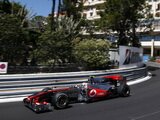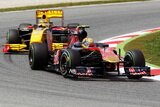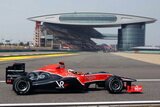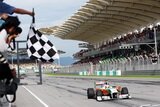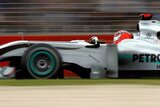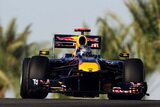Q: Is there anything in particular which will affect your team? Are you worried about the 107 per cent rule or anything like that?
CK: I don’t think we will be worried next year about the 107 per cent rule anymore. This year we are more afraid about the 107 per cent rule. I think it is the right decision to go with Pirelli, we were always in favour of Pirelli.
Q: And the movable rear wing?
CK: The more changes the better for a new team. I see it like this, to have maybe innovative ideas with the right people in the team.
Q: Peter?
Peter Sauber: About the tyres?
Q: About anything. You can talk about anything, even BMW Sauber if you like.
PS: I speak about the tyres. I think it is a good solution for Formula One. I am confident that they will do a good job. KERS, I think on the one hand, it is important for Formula One to use future technologies. On the other hand it makes the car more complicated and more expensive.
Q: So you are not necessarily in favour of KERS?
PS: I think the faster solution will be the better one. And the rear wing it’s a kind of miracle for me and please ask me again after the first three races next season.
Q: It is interesting to see the number of new ideas to help overtaking.
PS: I think maybe it is a good idea for overtaking, but I think we have different opinions from the technicians.
Q: Doctor Mallya?
Vijay Mallya: I have the proud privilege to be a member of the World Council as well and as Team Principal of Force India. I am obviously involved with FOTA as well as the F1 Commission. I think that everything is discussed comprehensively first by FOTA, then at the F1 Commission level before it gets to the World Council, so at the World Council level these changes were voted in without any problem whatsoever. I think the FIA is focussed on making the sport more exciting, to promote overtaking on one hand, maintaining and improving safety on the other hand, reducing costs which is a stated objective to make Formula One even more commercially viable and I would go along with these changes except that I would caution against repeated changes going forward. I think right now that we have a package that is to the satisfaction of all the participating teams.
Q: Aldo?
Aldo Costa: From my side I think the World Council voted for solutions that have been studied for a long time, a lot of work has been done by FOTA teams and a lot of the job has been done by the Technical Working Group. I think we achieved quite a lot of interesting innovation in Formula One. One point that no-one is underling but for me the safety aspect is important. The chassis with several little modifications would be safer for next year. The FIA as usual and the teams have looked at last year and this year’s crashes and, as usual, reacted on that making the chassis safer. We will have the front part of the chassis more robust, the roll loop more robust, the side protection of the chassis more robust. Underneath the chassis in the driver area. The driver will be more protected, so all very positive aspects. KERS, we spoke about already last time here. Ferrari is in favour of KERS. Ferrari would like to do more about KERS but unfortunately the rule that we had last year will be the rule of 2011 which is for us a shame. In terms of aerodynamic change we will have a substantial reduction of downforce without the double diffuser that for us was never a legal option. We will simplify and clarify all the rear wing elemental stuff which I think will be good for the clarity of the rule itself. We will have the introduction of the new adjustable rear wing. I have the same mixed feeling like Mr Sauber. It is a completely new element. We have not tested it. We have studied very, very little about it. We are going with it next year, so we will see after a few races. Anyway it is a movable option, so the FIA and the teams can always decide to stop it in case it is not good enough or not good for some reason. All in all I think we have done quite a good movement (inaudible word) a rule which is safer, clearer in terms of definition and again trying, a genuine attempt to improve the show.
Q: Colin, what about reliability, progress with the team. How do you feel you are coming along?
CK: Well, regarding reliability we still have some issues on the rear end. We are trying to sort this out obviously. Xtrac is pushing to find solutions. We experienced today in free practice on both cars rear end problems. I hope we will be fine for the weekend but obviously this is not satisfactory. In terms of progress obviously the team is making progress because we were just like a puzzle in Bahrain which was not really structured, so it has a proper structure now and we have a plan for next year how to move forward and I hope we will be successful with this.
Q: At one point there was some story about the financial situation of the team. Is that all settled down now?
CK: The story which you read was actually corrected one hour after the release because it was a wrong quote taken out of context. Obviously you have to look in a Formula One team every day how you find more sponsorship and how you survive. I think our situation is not better or worse than any of the smaller teams.
Q: Peter, you have had a rotten start to the season. It seems to have gone on and on. Can you see light at the end of the tunnel?
PS: First you have to solve the problem with the reliability, especially on the engine side. We have had a lot of engine failures, but, nevertheless, our co-operation with Ferrari is very good. Both parties are investigating the problems and are working hard to solve them.
Q: When it comes to other teams, what other teams are you looking at as your major rivals at the moment?
PS: I think it is Toro Rosso, maybe Williams. We are not close to Force India. At the moment they are far away. That’s the rivals.
Q: Doctor Mallya, equally tremendous performance from your team of late.
VM: Yes, you know it has been almost an evolution. When I acquired the team the performance wasn’t anything other than running around as back markers, so we put together a programme with a clear vision that in 2009 we should score some points. We did score some points but we were very lucky to land a podium at Spa. The objective for 2010 was to be a regular points scoring team, meaning running and finishing within the top 10. I think we are pretty much on track. I think we could have had a little bit of better luck in a couple of races but notwithstanding that I think we have 35 points, certainly more than this team has had in a decade. We are clearly capable of being in the top 10. We are racing Renault and Mercedes which is a nice position to be and we hope to keep improving. We haven’t stopped our development on the 2010 car. We will continue that as we want to score as many points as we possibly can this year. As I said next year we hope to target some podium finishes, particularly since the 2011 Indian Grand Prix is now looking like a reality. Nothing would give us more pleasure to be able to have a podium finish at the inaugural Indian Grand Prix.
Q: Give us some idea of the progress being made in India. How is that coming along?
VM: This is a very substantial group. It is called the JP Group. They are very large real-estate developers and infrastructure developers. They have got a huge tract of land and they are building sport city. On element of the sport city is the Formula One track. It is being designed by Mr Tilke who I think has several of the newer Formula One tracks to his credit. I bumped into him today when I was coming into the paddock and he said everything was on track. We have seen pictures, photographs, and there is some real progress, so now I can safely say that I am personally convinced that the track will be built. It will be completed and that there will be the inaugural grand prix next year.
Q: Aldo, first of all, looking back at Montreal where the team was pretty convinced it could have won, are you winners? Are you now in a position to win on various different types of circuit like here, or Silverstone?
AC: I would like to have the possibility to answer you in a certain way. Unfortunately, we don’t know. We are pushing a lot, we are very, very motivated. We brought a lot of improvements here, more for Silverstone, more in Germany, so we are pushing very, very hard. Canada could have been a very, very good race for us, but for a few circumstances, it wasn’t as great as it could have been. So we are convinced that we can get to the position we like.
Q: Give us some idea of the modifications that you’ve brought here, because the back end of the car is quite substantially modified, I believe?
AC: Yeah. Not only the back of the car but also the bodywork itself, so we have got a new radiator system in terms of the shape and concept, so there’s new bodywork. And the exhaust layout is completely different and the back of the car, as you said - floor, suspension - there are improvements as well in the middle part of the car.
Today was a very intense day because we had to do a massive amount of checks and a lot of kilometres. We solved some issues in free practice one, very, very quickly and in free practice two we were running OK. Felipe spun but this is the game. So everything in FP2 was OK.
QUESTIONS FROM THE FLOOR
Q: (Joe Saward - Grand Prix Special) Luca di Montezemolo has been talking a lot about third cars. Can I have your views on third cars; from the Ferrari point of view, how easy it is to do it, and from everybody else based on whether you think it’s a good idea, strategically, for Formula One?
CK: For me, two (cars) are enough. We wouldn’t do three cars. I think doing three cars is more for the top teams. We are not in a position to run three cars.
PS: Now we are twelve teams, I don’t think it’s necessary to bring three cars. If you go down to seven teams, it could be necessary.
VM: I’m obviously concerned with the number of cars on the grid. At certain tracks, I personally feel that the number of cars we currently have are perhaps a tad too much, or too many. But I’m not opposed to the idea of a third car at all. The incremental cost of building and running a third car is not that great, so if the need arises, we’re quite happy to do it.
AC: I don’t know what to comment, really. I think Mr Montezemolo’s proposal was done in case there were not many cars on the grid, so big teams would have been available to run three cars. That’s what he thinks. I’m convinced that with a good notice period we can do it, not this year. It would not be possible for us to run three cars, not even next year, because with the current resource restrictions we are running with minimal spares, with very few chassis. I think all teams will be obliged to do that, so overnight we could not run a third car. If we were well programmed, yes, we are keen and available.
Q: (Joe Saward - Grand Prix Special) Just to follow up on that, the FIA made a statement about licences for leading members of teams. How do you feel about being licensed to the FIA, and Vijay, how do you feel about licensing yourself?
VM: I was part of the discussion at the World Council on the whole issue of licensing. I think this has all come about arising out of some recent judgements whether the FIA has authority to impose penalties on people involved in Formula One. If they are licensed by the FIA, then the FIA has some jurisdictional control.
We do nothing wrong, we come here to race, we race cleanly, we race according to the sporting regulations. I don’t care if I have to be licensed, I’m quite happy to be licensed.
AC: I do not have a strong opinion on this.
CK: To be honest with you, if the FIA decides I have to be licensed I’m happy with that. I have no issue.
PS: Yeah, the same for me.
Q: (Joe Saward - Grand Prix Special) There’s been a lot of movement of technical staff recently. Aldo, you’ve hired a deputy technical director (Pat Fry). Can you tell me what a deputy technical director actually does and is there any truth to the rumours that Nikolas Tombazis is going somewhere else?
AC: When we knew that Pat was free and was looking around for a new challenge, we spoke with him and with other teams as well, because from what we knew, he had quite a lot of contacts and we arrived at a final agreement which for me was very, very good. Pat has got huge experience and I think he can join us and help us to have a stronger team. He’s not coming to replace anyone, so it’s not true that Nikolas will leave. Nikolas is a great asset of Ferrari and we want him to stay with us. So he will join the group and we will re-distribute the job between myself and my first level of engineers, having the possibility, with one more person, probably to follow the technical development in a wider and deeper way with the group of senators.
Q: (Gaetan Vigneron - RTBF) Vijay, following on from that, looking from the outside, in the last few weeks you have lost quite a few people on the technical side in your team. It might look a little bit worrying, so what is the reality and what’s your point of view on that?
VM: You know, the Formula One team is not the only organisation that I run. I have several organisations across the UB Group and my mantra is very clear: nobody is indispensible. Having said that, if people decide to leave and join another team, they are welcome and free to do so and we will find suitable and equally competent individuals to replace them. It’s ironical that most of them are headed to one particular team. I wish them luck.
Q: (Alan Baldwin - Reuters) Dr Mallya, you spoke about the Indian Grand Prix next year; you have the Indian team, the man behind you has the Indian driver. How long will we have to wait for an Indian driver in an Indian team?
VM: Let’s be clear; motor sport is not that advanced in India for a variety of reasons, to throw up drivers who would ultimately reach Formula One. We have drivers - Narain Karthikeyan, Karun Chandhok, and a couple of others, Armaan (Ebrahim), and there’s a boy called Patel - they’re talented drivers. Now I must decide whether they suit my requirements in Force India Formula One or not. I have been very fair, I’ve given at least one of them the opportunity in the driving simulator and I put four drivers in and I selected the best one of the lot which happened to be Paul di Resta, so it isn’t as if I’ve got a shut mind here. But I’ve got to start looking for somebody really young, and as I have said to you before and to many others, amongst 1.2 billion people there’s got to be a Lewis Hamilton somewhere. It’s like trying to pick a needle from a haystack, but we are now going to launch a nationwide programme in India to identify young talent and this is a pretty complex exercise. It involves several karting tracks all over the country, a whole organised method of getting people to enter, a competitive environment, a competitive programme and then we will probably take those with exceptional talent, bring them to either England or Europe, pay for them, pay for their education, pay for their karting and literally mentor them through until they can sit in a Formula One cockpit, and we are absolutely committed to do that.
Q: (Alan Baldwin - Reuters) Is that going to be a Force India driver academy, a young driver academy of some sort?
VM: Absolutely, absolutely yes.
Q: (Gaetan Vigneron - RTBF) For all of you: are you watching the GP2 races and what does a GP2 driver eventually have to do to attract your attention and to be in your team eventually next year?
CK: I’m not watching only GP2 races, I’m also watching F3 races and other categories. There’s always a talent around. Sebastian Vettel drove in my Formula Three car when he was 15. He never drove GP2, so you have to look not only at GP2.
AC: As you know, Ferrari has started the activity on a driver academy and actually one of the GP2 drivers, Jules Bianchi, is one of our drivers, so we look at GP2 pretty closely. We are pretty close to Jules as well.
VM: Yes, I do watch GP2 and clearly there are several drivers from GP2 who have graduated into Formula One, so that’s obviously a pool that’s available to chose from. But once again, I’ve got a pretty good line-up of drivers now. I’m quite happy with them. They’re not at the end of their careers, in fact they are at the prime of their careers. But I’d rather identify a good Indian going forward but if the need arises, then obviously GP2 or F3 is probably the most popular hunting ground, isn’t it.
PS: Yes, of course, we follow most series: GP2 and GP3, but it’s not so important for us because we have a rookie in Kamui (Kobayashi) and one is enough.
Comments:


